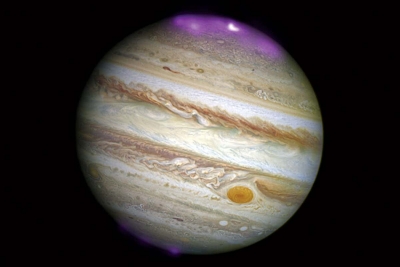
The most powerful auroras in the Solar System occur in the atmosphere over Jupiter’s poles. Here, the planet’s strong magnetic field accelerates charged particles to energies of 400 kiloelectron volts (keV), which is between 10 and 30 times more powerful than the highest auroral electric potentials observed on Earth.
These measurements of Jupiter’s aurora were made in 2017 by the Juno spacecraft’s Jupiter Energetic Particle Detector Instrument (or JEDI). Curiously, the measurements revealed that the strongest peaks of electric potential were not closely correlated with peaks in auroral activity, as they are on Earth. The mechanisms behind the variation in Jupiter’s aurora is still unknown.
Earth’s auroras are caused by interactions between the planet’s magnetic field and the constant bombardment of charged particles (free electrons and protons) known as the solar wind. The Earth’s magnetosphere deflects most of this barrage, but particles of the solar wind entering the Earth’s magnetic field at the poles are channelled by the magnetic field in to the Thermosphere region of the atmosphere, where they collide and interact with gas molecules.
These interactions cause molecules of gas to become “excited”, or made unstable by an injection of additional energy. As they return to a stable state, they emit energy in the form of light. This is the same process as takes place inside a neon sign (where electricity takes the place of solar wind). As with neon signs, different elements produce different wavelengths of light (colours) – oxygen generally gives off green light, while excited nitrogen glows blue or red.
Jupiter’s magnetosphere is so large and powerful that all solar wind is deflected long before it can interact with the planet’s atmosphere, about 3 million kilometres (1.86 million miles) away. As a result, most of the charged particles that feed Jupiter’s aurora must come from inside the planet’s protective bubble. The most likely origin for the particles is the inner moon Io, famous for its constant, violent volcanic eruptions, which are powerful enough to launch highly energized material out into orbit around Jupiter. This material is then accelerated by the currents of Jupiter’s magnetic field as it is pulled down towards the planet’s poles. The process is effectively a colossal, naturally occurring particle accelerator, akin to the magnetic confinement systems in human-made equipment such as the Large Hadron Collider.
Credit : Guinness World Records
Picture Credit : Google




